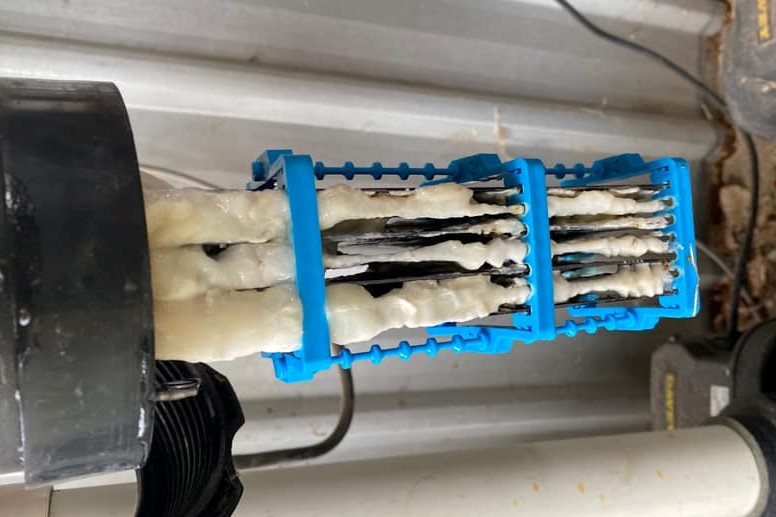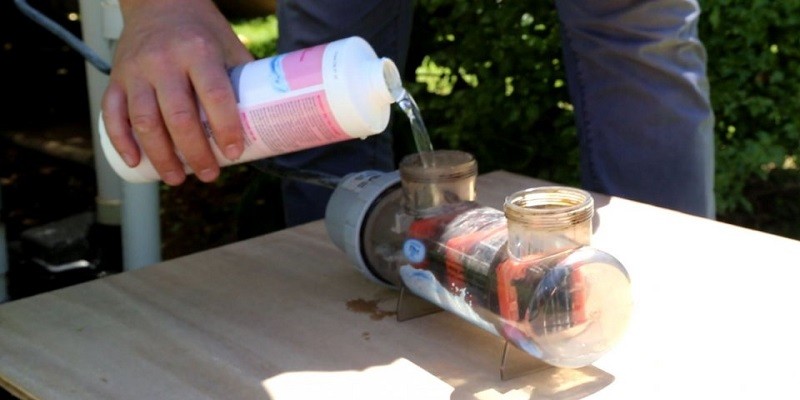Last Updated on September 10, 2023
Clean a salt cell by carefully removing it from the chlorinator, soaking it in a solution of acid and water, and brushing away any buildup. When cleaning a salt cell, it is important to follow the manufacturer’s instructions and wear protective gloves and eyewear to prevent injury.
Proper cleaning of the salt cell will help maintain its efficiency and extend its lifespan. Salt cells are an essential component of saltwater pools as they generate the chlorine needed to keep the water clean and sanitized. However, over time, mineral deposits and calcium buildup can accumulate on the cells, affecting their performance.
Regular cleaning of the salt cell is crucial to ensure its optimal functioning. This article will provide a step-by-step guide on how to effectively clean a salt cell to remove any debris or scale that may hinder its efficiency. By following these simple cleaning procedures, you can prolong the life of your salt cell and enjoy crystal clear pool water all summer long.

Credit: www.myperfectpool.com.au
The Importance Of Salt Cell Cleaning
Regular cleaning of your salt cell is crucial for its longevity and to ensure optimal performance of your pool. Dirty salt cells can have detrimental effects on the quality of your pool water and can even lead to costly repairs if neglected.
It’s important to be aware of the common signs that indicate when it’s time to clean your salt cell. Let’s dive deeper into these important aspects:
Importance Of Regular Cleaning For Salt Cell Longevity
Regular cleaning plays a vital role in extending the lifespan of your salt cell. Here’s why it’s important:
- Prevents mineral buildup: Over time, minerals like calcium and magnesium can accumulate on your salt cell plates, inhibiting the generation of chlorine. Regular cleaning eliminates these deposits, ensuring efficient chlorine production.
- Maintains optimal performance: A clean salt cell ensures that chlorine levels in your pool water are consistent, keeping it free from harmful bacteria and algae. This helps maintain water clarity and reduces the need for additional sanitizers.
- Avoids costly repairs: Neglected salt cells can become clogged with stubborn deposits, leading to reduced efficiency and potential damage. Regular cleaning prevents blockages and prolongs the life of your salt cell, ultimately saving you from expensive repairs or replacements.
- Promotes energy efficiency: When your salt cell is clean, it requires less energy to generate chlorine. This translates to energy savings and a more sustainable pool maintenance routine.
Effects Of Dirty Salt Cells On Pool Water Quality
Dirty salt cells can have several negative effects on the quality of your pool water. Here’s what you need to know:
- Reduced chlorine production: Mineral buildup on the salt cell plates restricts the generation of chlorine, resulting in inadequate sanitization. This can lead to poor water quality, an increased risk of waterborne illnesses, and an unsightly pool.
- Algae and bacteria growth: When chlorine levels drop due to dirty salt cells, it creates an environment conducive to algae and bacteria growth. This can cause the water to turn green, cloudy, or even develop an unpleasant odor.
- Increase in chemical usage: To compensate for the diminished chlorine production, you may find yourself using additional chemicals to maintain proper water balance and eliminate contaminants. This can be time-consuming and expensive, adding unnecessary hassle to your pool maintenance routine.
Common Signs That Indicate It’S Time To Clean The Salt Cell
Recognizing the signs that your salt cell requires cleaning is essential in preventing potential issues. Look out for these indicators:
- Low chlorine levels: If your chlorine levels are consistently lower than desired despite proper chemical balance, it could indicate that your salt cell is dirty and needs cleaning.
- Algae growth: The presence of algae in your pool, despite maintaining proper maintenance practices, suggests that your salt cell isn’t functioning optimally. It’s time to give it a thorough cleaning.
- Scaling or deposits on cell plates: If you notice white or grayish scaling on the cell plates, it signifies mineral buildup. Cleaning the salt cell is necessary to restore its efficiency.
- Reduced water clarity: Cloudy or dull water can be a result of a dirty salt cell. Cleaning it will help eliminate the residue affecting water clarity.
- Visible damage or corrosion: Physical damage or corrosion on the salt cell plates is a clear indication that cleaning is required to prevent further deterioration.
By understanding the importance of regular cleaning for salt cell longevity, the effects of dirty salt cells on pool water quality, and recognizing the signs that indicate it’s time to clean the salt cell, you can maintain a clean and safe swimming environment for everyone to enjoy.
Take the necessary steps to keep your salt cell in top shape, keeping your pool water crystal clear and refreshing all season long.
Gathering The Necessary Supplies
Essential Tools And Equipment For Cleaning A Salt Cell:
- A soft brush or sponge: To scrub away any buildup or scale on the salt cell.
- A bucket of warm water: To mix with cleaning solution and soak the salt cell.
- Cleaning gloves: To protect your hands from any harsh chemicals.
- Safety goggles: To shield your eyes from splashing cleaning solutions and debris.
- Vinegar or muriatic acid: Recommended cleaning solutions for effective removal of calcium scale and mineral deposits.
- Plastic or non-metallic scraper: To gently scrape off any stubborn deposits on the salt cell.
Importance Of Safety Precautions While Cleaning The Salt Cell:
- Safety should always be the top priority when cleaning a salt cell to avoid any accidents or injuries.
- Wear protective gloves and goggles to shield yourself from harsh chemicals and debris.
- Ensure proper ventilation in the area where you are cleaning the salt cell.
- Turn off the power to the salt cell system before starting the cleaning process.
- Follow the manufacturer’s instructions and guidelines for cleaning the salt cell to prevent damage.
- Avoid using any abrasive tools or materials that can scratch the surface of the salt cell.
Recommended Cleaning Solutions For Effective Results:
- Vinegar solution: Mix equal parts of vinegar and water in a bucket and soak the salt cell for about 30 minutes. The acidity of vinegar helps dissolve and remove mineral deposits.
- Muriatic acid solution: Dilute muriatic acid with water according to the manufacturer’s instructions. Be cautious while handling muriatic acid as it is highly corrosive. Soak the salt cell in the solution for a few minutes and then rinse thoroughly.
- Salt cell cleaner: There are specific cleaning products available in the market designed specifically for salt cells. Follow the instructions on the product label for optimal results.
- Regular maintenance: Regularly inspect and clean the salt cell to prevent excessive buildup. This helps maintain the efficiency and lifespan of the salt cell.
Remember to always consult the manufacturer’s instructions and guidelines before cleaning the salt cell. Regular cleaning and maintenance of the salt cell will ensure it functions optimally, providing you with clean and clear pool water.
Step-By-Step Guide To Cleaning A Salt Cell
Step 1: Disconnecting And Isolating The Salt Cell:
- Begin by turning off the pool pump and ensuring that it is no longer running.
- Locate the salt cell and identify the unions or connectors that attach it to the plumbing system.
- Use a wrench or pliers to loosen the unions and carefully disconnect the salt cell from the system.
- Once disconnected, place the salt cell in a safe and accessible area for cleaning.
- Make sure to turn off the power supply to the salt cell to avoid any risk of electrical shock.
Step 2: Removing Excess Debris And Buildup From The Cell:
- Use a hose or pressure washer to rinse off any visible debris or loose buildup from the salt cell.
- Pay extra attention to the electrodes on the cell, as they tend to accumulate the most deposits.
- Gently scrub the cell using a soft brush or sponge to remove any stubborn debris that may be stuck on the surface.
- If the buildup is too stubborn, consider using a specialized cleaning tool or a plastic scraper to avoid damaging the cell.
- Take care not to exert too much pressure while cleaning to prevent any potential damage to the cell’s delicate components.
Step 3: Soaking The Salt Cell In The Cleaning Solution:
- Prepare a cleaning solution by mixing equal parts water and vinegar in a bucket or container.
- Submerge the salt cell in the cleaning solution, ensuring that all parts are fully immersed.
- Allow the salt cell to soak for at least 30 minutes to loosen and dissolve any remaining deposits.
- For more severe buildup, you can extend the soaking time to a few hours or even overnight.
- During the soaking process, avoid using any harsh chemicals or abrasive cleaners, as these can damage the cell.
Step 4: Scrubbing The Salt Cell To Remove Stubborn Deposits:
- After soaking, take the salt cell out of the cleaning solution and inspect it for any remaining deposits.
- Use a soft brush or sponge to gently scrub the electrodes and other areas of the cell to dislodge any remaining buildup.
- Pay extra attention to areas with thick deposits, ensuring that you thoroughly scrub them to remove all traces of buildup.
- If necessary, you can use a toothbrush or a small, soft-bristle brush to reach into tight spaces and corners.
- Rinse the salt cell with clean water to remove any loosened residue before moving on to the next step.
Step 5: Rinsing And Reassembling The Salt Cell:
- Thoroughly rinse the salt cell with clean water to remove any traces of the cleaning solution.
- Ensure that all electrodes and surfaces are completely free of debris or cleaning residue.
- Take this opportunity to inspect the cell for any signs of damage or deterioration that may require repair or replacement.
- Once the salt cell is clean and dry, carefully reassemble it, reconnecting it to the plumbing system using the previously loosened unions or connectors.
- Make sure to tighten the unions securely to prevent any leaks.
Step 6: Testing The Salt Cell After Cleaning:
- Turn on the pool pump and restore power to the salt cell.
- Check the display panel or controls to ensure that the salt cell is functioning properly and producing chlorine.
- Monitor the chlorine levels in the pool over the next few days to ensure that they remain within the recommended range.
- If there are any issues or if the chlorine levels are not sufficient, you may need to repeat the cleaning process or consult a professional for further assistance.
- Remember to regularly clean your salt cell to maintain optimal performance and extend its lifespan.
Maintenance Tips To Extend The Lifespan Of Your Salt Cell
Regular maintenance is essential for maintaining the performance and longevity of your salt cell. By following these simple tips, you can optimize its efficiency and minimize the need for frequent cleanings. Take a look at the following recommendations:
- ### importance of routine inspections and preventive measures:
- Inspect your salt cell regularly to identify any signs of debris buildup or scaling.
- Clean the cell at least once every three months, or as recommended by the manufacturer.
- Ensure that the basket is free from leaves, twigs, or any other foreign objects that may clog the system.
- Regularly check the salt levels in your pool to maintain the optimal salinity required for the cell’s operation.
- ### tips for minimizing the need for frequent cleanings:
- Properly balance the pool’s ph and alkalinity levels to prevent scale formation on the salt cell.
- Regularly backwash and clean your pool’s filter to minimize impurities entering the salt cell.
- Keep the pool free from debris by utilizing a pool cover when not in use.
- Install a sacrificial anode to protect the salt cell from corrosion caused by mineral imbalances.
- ### monitoring salt levels and other factors affecting cell performance:
- Ensure that the salt levels in your pool are within the recommended range specified by the manufacturer.
- Monitor the water temperature as extreme temperatures can affect the overall performance of the salt cell.
- Check the cell’s power supply and make sure it is functioning properly.
- Keep an eye on the water flow rate to ensure it is consistent and not hindered by any obstructions.
- ### common mistakes to avoid while cleaning a salt cell:
- Never use metal tools or wire brushes to clean the cell, as they can damage the delicate coating.
- Avoid using abrasive or harsh chemicals that can corrode or degrade the cell’s surface.
- Never skip the rinsing step after cleaning, as leftover cleaning agents can affect the cell’s performance.
- Do not over-clean the cell, as excessive cleaning can wear out the cell’s coating prematurely.
By adhering to these maintenance tips, you can prolong the life of your salt cell and ensure that it functions optimally. Regular inspections, preventive measures, and monitoring various factors will contribute to the overall performance of your salt cell, offering you clean and safe pool water throughout the swimming season.
Frequently Asked Questions On How To Clean A Salt Cell?
How Often Should I Clean My Salt Cell?
Clean your salt cell every 3 to 6 months to ensure optimal performance and longevity.
What Tools Do I Need To Clean A Salt Cell?
You’ll need a soft brush, a solution of diluted acid, gloves, eye protection, and a bucket.
Can I Clean A Salt Cell Without Removing It From The System?
Yes, you can clean the salt cell without removing it. Follow the manufacturer’s instructions carefully.
How Do I Remove Stubborn Scale Build-Up From The Salt Cell?
Soak the salt cell in a solution of vinegar and water for about 15 minutes to dissolve the scale.
What Precautions Should I Take When Cleaning A Salt Cell?
Turn off the salt system, wear protective gear, and follow the safety guidelines provided by the manufacturer.
Conclusion
Cleaning a salt cell is an essential part of maintaining your pool or spa. By following the proper steps and using the right tools, you can prolong the life and efficiency of your salt cell. Start by turning off the power to the system and removing the cell.
Rinse the cell with a high-pressure hose to remove debris and buildup. Then, using a cleaning solution specifically designed for salt cells, soak the cell to dissolve any remaining deposits. After cleaning, rinse the cell again and reassemble it back into the system.
Regularly cleaning your salt cell will prevent clogging and ensure optimum performance. Remember to consult your manufacturer’s instructions for specific cleaning recommendations. By maintaining a clean salt cell, you can enjoy crystal-clear water and extend the lifespan of your pool or spa equipment.
So, don’t neglect this important task and keep your pool or spa in tip-top shape.










